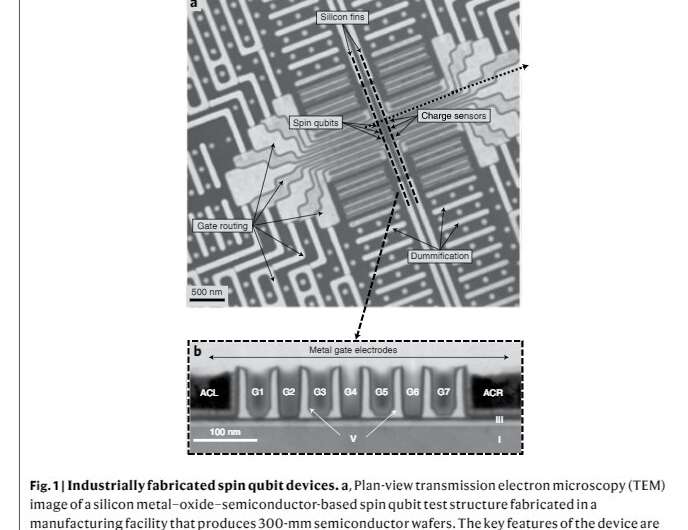Fabricating qubits using advanced semiconductor manufacturing processes

Quantum computers are promising computing machines that perform computations leveraging the collective properties of quantum physics states. These computers could help to tackle many computational problems that are currently intractable with conventional computers.
Despite their promise, fabricating quantum computers on a large-scale is currently very challenging, as a full-scale quantum computer integrates millions of qubits. To ensure that they can be produced using industrial semiconductor manufacturing processes, quantum device engineers have been trying to create quantum computers based on silicon quantum dots.
Nonetheless, existing quantum computers have been primarily fabricated using electron-beam lithography and conventional lift-off processes. This greatly limits their production rates, as both these processes only yield a few properly functioning devices at a time.
As part of a recent study, researchers at Delft University of Technology (TU Delft) and Intel Corporation successfully fabricated quantum dots at a 28Si/28SiO2 interface using alternative and advanced processes, at an Intel semiconductor manufacturing facility. Their paper, published in Nature Electronics, demonstrates the feasibility of building full-scale quantum devices relying on the current manufacturing infrastructure.
“This work builds on twenty years of exploratory research in semiconductor spin qubits at QuTech, and on many decades of advanced semiconductor manufacturing development at Intel,” Lieven Vandersypen, one of the researchers at TU Delft, told Tech Xplore. “The primary objective was to unite these two worlds in a joint research project, realizing semiconductor qubits using Intel’s advanced manufacturing facilities.”
The researchers’ silicon quantum dots were fabricated at an Intel facility, using all-optical lithography and fully industrial processing processes. Optical lithography, also known as photolithography, is a manufacturing technique used to transfer a pattern onto a substrate using a photosensitive material.
“We leveraged our transistor manufacturing expertise to create a customized research and development line for qubits,” Ravi Pillarisetty, a Quantum Device Engineer at Intel, told TechXplore. “This allows us to tap directly into our rich history of process innovations that have driven Moore’s law over the last 50 years.”
The recent work by this team of researchers shows that fabricating uniform and reliable qubits on a large-scale, using existing manufacturing processes, is possible. The qubits they created are directly compatible with the advanced interconnect and circuit design schemes that are associated with the current manufacturing of semiconductors.
“For years, the community has claimed that semiconductor spin qubits can leverage the extensive know-how and technology of the electronics industry,” Vandersypen said. “In this work, we finally show this is true. Being able to leverage this technology boosts the prospects of creating millions of qubits that all work.”
In the future, the recent work by Vandersypen, Pillarisetty and their colleagues could pave the way towards the large-scale and reliable manufacturing of qubits for quantum computers and other quantum technologies. Meanwhile, the team at Intel and TUDelft plans to explore ways in which the manufacturing processes they used could be optimized further.
“Our research and development line allows us the capability to run high volume experiments to understand how our process can be modified to improve qubit performance and quality,” Pillarisetty added. “Additionally, we are leveraging our CMOS infrastructure to identify pathways to scale to large size qubit systems.”
A. M. J. Zwerver et al, Qubits made by advanced semiconductor manufacturing, Nature Electronics (2022). DOI: 10.1038/s41928-022-00727-9
© 2022 Science X Network
Citation:
Fabricating qubits using advanced semiconductor manufacturing processes (2022, April 21)
retrieved 21 April 2022
from https://techxplore.com/news/2022-04-fabricating-qubits-advanced-semiconductor.html
This document is subject to copyright. Apart from any fair dealing for the purpose of private study or research, no
part may be reproduced without the written permission. The content is provided for information purposes only.
For all the latest Technology News Click Here
For the latest news and updates, follow us on Google News.

